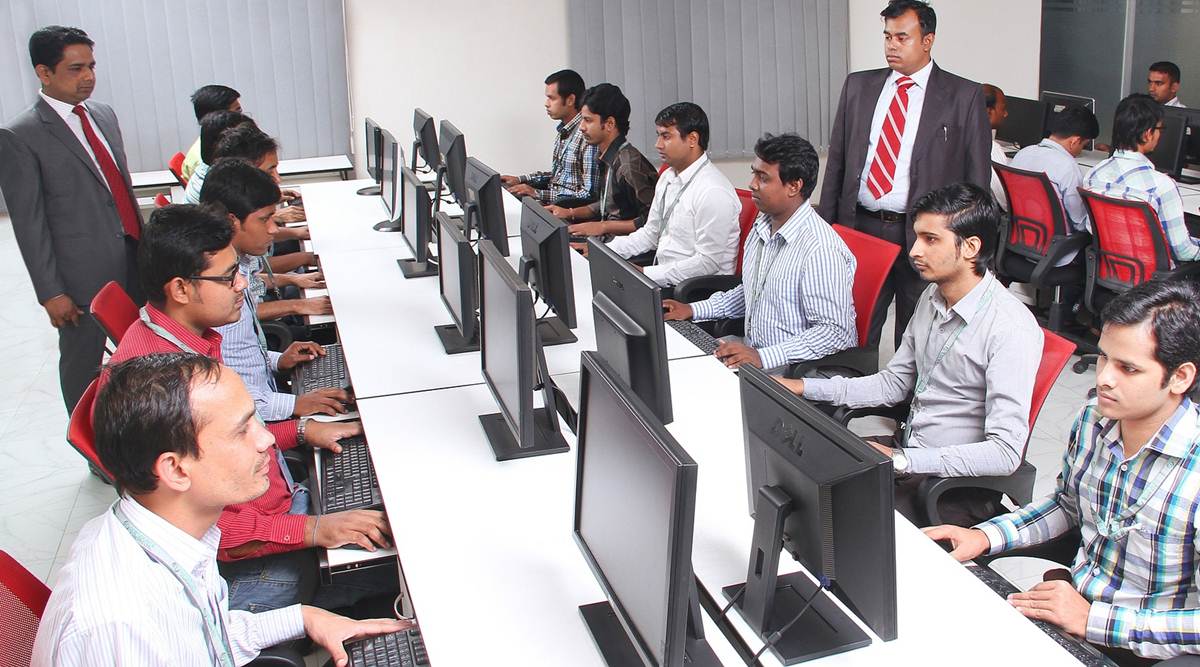At One Side, India Is Struggling with unemployment; on the other side, too many people are resigning from their jobs

At One Side, India Is Struggling with unemployment; on the other side, too many people are resigning from their jobs
According to a poll conducted by Randstad NV, a global provider of employment services, the Great Resignation is showing no signs of abating. A shrinking supply of workers may be here to stay. The word has been popular since last year, and it is said to be reflecting the growing trend of people quitting employment, or more of a reshuffle, with swarms of employees abandoning their existing roles in search of better ones.
Due to the events over the last two years, employees’ attitudes have evolved permanently. According to the poll, many people have realized that happiness is critical to success in life and at work, and they are willing to tell their bosses how they feel.
In India, 63 per cent of respondents stated they would rather be unemployed than miserable in their current position. Moreover, half of the poll respondents (68%) indicated they would quit a job if it prevented them enjoying their lives. Almost half of those polled (49%) said they would leave a job if it prohibited them from enjoying life.
About 70% of those polled felt that their personal lives are more important than their professional lives, and 61% indicated they would choose not to work if money were no obstacle.
Even though 95% and 91 per cent of those asked believe flexible hours and workplace are essential, most respondents claimed they don’t have a choice about where they work, and two-fifths don’t have control over their hours, according to the research.
Companies are increasingly summoning their staff back to the office, at least for part of the week, as the number of Covid-19 cases declines. Many employers, however, have yet to urge all staff to return to work in full.
The problem of job creation in India is becoming a more significant threat: an increasing number of individuals are no longer seeking work.
According to recent statistics from the Centre for Monitoring Indian Economic Pvt, a private research business in Mumbai, millions of Indians, particularly women, are leaving the labour field totally because they can’t find suitable employment.
The recent figures are an awful omen for India, counting on young people to fuel growth in one of the world’s fastest-growing economies. The total workforce participation rate fell from 46 per cent to 40 per cent between 2017 and 2022. The picture is considerably bleaker for women. Around 21 million people dropped out of the workforce, leaving only 9% of the eligible population working or searching for work.
According to the CMIE, more than half of the 900 million Indians of legal working age (approximately the population of the United States and Russia combined) do not want to work.
India’s job problem is both a difficulty and an opportunity.

According to statistics, India faces unemployment, job quality, and income quality problems. According to figures from the Centre for Monitoring Indian Economy (CMIE), India’s unemployment rate was 8.1 per cent in February 2022. While this is an improvement above the near-12% unemployment rate seen during the second Covid-19 wave’s peak in May 2021, just 40% of Indians were working or searching for work, compared to around 60% in other countries.
Around 26% of Indian males between the ages of 20 and 30 who had at least ten years of schooling were unemployed, whereas 2% of those over 30 were unemployed. According to data, India’s informal services and contract labour industry employs millions of people. Still, only around 5% of the workforce is formally skilled, compared to 75% in Germany and 96% in South Korea.
Furthermore, India currently has one of the lowest female labour participation percentages globally, having fallen from around 35% in 2005 to 21%, compared to the global average of 50%. Many of the employment that returned with the post-Covid-19 economic rebound went to men, while women continue to be disadvantaged.
These data points and the problems they signal for India were reviewed with Naushad Forbes, whose book ‘The Struggle And The Promise: Restoring India’s Potential’ discusses solutions to these concerns. Forbes Marshall, India’s largest steam engineering and control instrumentation business, is co-chairman of Forbes Marshall.
Forbes earned his bachelor’s, master’s, and doctorate degrees from Stanford University in California, where he taught for 20 years. Forbes is a board member of various educational institutions and public enterprises and has written extensively on India’s innovation, emerging nations, and higher education.
What are the challenges and opportunities in India in terms of employment?

Our most pressing public policy issue and our country’s greatest challenge and potential are employment.
The fight is [apparent] in the numbers you cited. To begin with, India’s labour force participation rate is relatively low. By worldwide standards, the figure of 40% is relatively low. Then there’s India, which has the lowest female labour force participation rate among the world’s top 20 economies, far lower than Bangladesh and even lower than Saudi Arabia, which isn’t a place you’d want to compare female employment chances with.
Third, India’s labour sector has a large number of informal jobs. Much work is spent in policy circles focusing on policies required for formal occupations, such as labour rights, etc. However, official domains account for just around 15% of overall employment in the country; over 85% of jobs are informal. This encompasses agriculture, as well as large industries like retail. It’s modest, owner-managed stores with two or three assistants, someone brewing tea on the side of the road, a fruit vendor with a handcart, and a security guard.
These are the sorts of employment that account for most of India’s hundreds of millions of jobs. That is where the challenge begins, with low labour force participation, particularly among women, and a highly skewed labour market in which the majority of occupations are informal.
So, where’s the chance, where’s the promise? Economic history shows that the most critical single engine of a country’s growth and prosperity as it evolves is the shift of individuals from lower-productivity jobs to higher-productivity occupations. In India, we still have this possibility. Agriculture employs 120 million people, yet we don’t need them.
Consider the early days of the epidemic, when workers reversed their movement. They returned because they had no option, not because possibilities had suddenly appeared in their villages, but because they had family who would support them if left with nothing. They’d lost their part-time work in the cities. However, returning to the countryside detracted from India’s total GDP development since they would earn less, which would show up as a negative.
According to my calculations, India’s GDP was reduced by around 0.5 per cent due to the reverse movement of 10 million people. Those ten million employees have yet to return to their hometowns. We’ve seen a surge in agricultural employment over the last two years, which is incredible, unprecedented, and unsustainable for a country like ours. India now has an overabundance of low-productivity farmland. Because [migrant workers] had no other option, we’ve added to the over-employment. All of this is a part of the battle.
This is also an opportunity since GDP growth will accelerate as those 10 million employees return to cities. People will become more affluent, spending more money, and the economy will once again be able to function effectively due to these multiplier effects.
So here’s the deal: if we can get millions of people to work more productively in better-paying jobs, we can produce an economic miracle that will last for 30 years and support all of India’s and the world’s industries. It’s in everyone’s best interests.
Why don’t Indian employees want to return to their offices in 2022?

Many of us have returned to WFH in the face of an increase in the number of patients. While it may be busy for some, many of us enjoy it.
Rising Covid-19 instances across the country have driven Indian enterprises to return to working from home, as they think their employees’ health and safety are their main priority. Some businesses that had allowed employees to come to work from November to December have suddenly reverted to work-from-home mode.
The government agencies have indicated that 50% of their employees will be present in their workplaces. Employees in the private sector are also being asked to work from home. Several IT firms, including Cognizant, Amazon, and Flipkart, have reintroduced work-from-home policies, expecting that all staff will return to the office in April. On the other hand, the majority of employees are not ready to return to their office quarters.
Why do Indians choose to work from their homes?

Debina Roy, an employee at an IT firm, discovered a new work pattern. She takes care of her domestic tasks while waiting for a response from a customer.
She claims that she is enjoying her best life right now since she is not wasting time driving three hours to work and back. Second, she is relieved to be out of a high-pressure atmosphere. Working from home makes her feel at ease. According to another employee who did not want to be identified, working from home allows him flexibility since he can customize his work environment to suit his needs. “I can organize my work as my own,” he remarked.
When we asked HRs about this, they responded that staff are away from their workplaces and feel closer to one another. They are also loving their work and working with zeal.
Healthy family money, career flexibility, freedom, time for themselves, and not having eyes continuously checking up on them are all possible reasons.
Travel is one of the top issues for employees, according to recruiters. Several employees were forced to relocate for employment in other states or cities. Still, the majority have already returned to their hometowns and may again work from the comfort of their own homes.
They will have more time to spend with their family. Employees also feel that working from home necessitates laptop computers and a reliable internet connection. These two factors will enable workers to operate productively from any location, such as hill stations or beaches.
Employees also feel that working from home necessitates laptops and a reliable internet connection.
Employees benefit from hybrid models

The majority of employees want a hybrid working paradigm in which they may operate in both online and offline modes. In the third wave of Covid-19, most enterprises choose hybrids.
Employees have shown an interest in returning to work in a hybrid environment.
Better infrastructure, alignment with organizational culture, social connection and bonding with colleagues, and fewer distractions are the reasons for this.
The hybrid work paradigm emphasizes work-life balance and flexibility between online and offline modalities. According to several studies, the hybrid approach will be the most effective and will likely be used.
Employees who work from home are most of the women.
Because most women have additional duties, such as domestic tasks and caring for their families, they may choose to work from home more than males.
Women who work from home can combine their employment and household responsibilities. However, due to their firms’ work-from-home policies, they are being burdened by a more significant share of household tasks and obligations.
Even when both couples work from home, women remain responsible for the bulk of household duties.

Neha Sharma, an IT employee, claimed that she described her work environment to her family members before the pandemic and told them that she would work during those hours since her office had relocated to her house and needed their support. The family, on the other hand, is still assisting.
“My husband and I both work from home,” she explained, “but I still have to look after my family.”
Women can work from home more effectively if their families support them; nevertheless, if this is not possible, they prefer to work from the office because it provides just work stress.
Which is better: working from home or working from an office?

Since India has switched toward enabling digital technology as the future of work, this dispute has erupted among employees. This is another point of contention: is it preferable to work from home or an office?
Many employees believe that working from home is preferable because it eliminates travel, allows for a better work-life balance, and saves money. In contrast, others believe that working from the office is preferable because it allows for face-to-face communication with coworkers and allows them to manage everything on their own.
The findings suggest that productivity is higher when working from home than in an office.
Employees who work from home are 47 per cent more productive, spend 10 minutes less each day being unproductive, and work one additional day per week.
Employees who work from home desire a better work-life balance and financial exposure. Maintaining a workplace culture after a pandemic is difficult.
Employees now plan to provide organized and unstructured time to participate, communicate, and discuss their lives and work.




